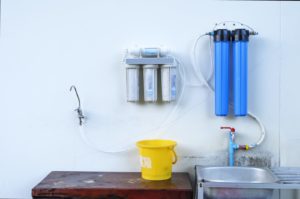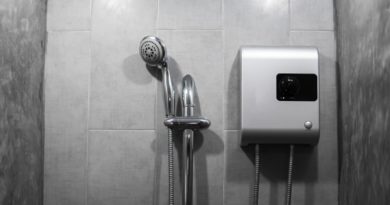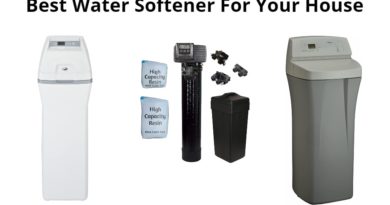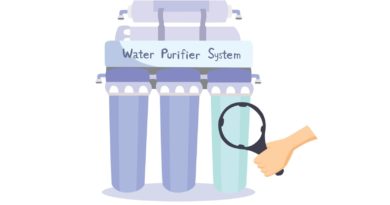Best Reverse Osmosis Systems
**Articles may contain links that I earn compensation for if clicked and you make a purchase. As an Amazon Associate, I earn from qualifying purchases. These earnings do not actually impact the price of the product or service.
Much like a water softener, a Reverse Osmosis Systems can be a great tool to get hard water out of your home. They come in smaller single-application use and also full systems for your whole home. Reverse Osmosis can be a complicated filtration system that most people do not understand. In this article, we go over how RO systems work and also list out our top picks. This way, you can better understand the system and choose the best one for you.
Table of Contents
What Is It?
Reverse Osmosis is a process in which contaminants or certain minerals are removed from the water. It does this by forcing it with pressure through a semipermeable membrane covered with molecules. Water is pushed from the contaminated side through the membrane to the filtered side. The system includes the permeate, which is the freshwater produced, and the brine, which is the concentrated contaminated water.
In the process of Osmosis, minerals are added to water to become more concentrated to reach equilibrium. Reverse Osmosis works to block the contaminants, which is perfect for getting hard water filtered into soft water for your home. This also works for saltwater from the ocean. In water filtration plants, pressure is applied to saltwater, and through reverse osmosis the salt is left behind and produces clean water to drink.
It is a complicated process, but understanding exactly how the system works can help you best determine the specific features you want your system to have.
How Does it Work?
The RO system for your home works using two different filters depending on the type of system you get. Typical water is passed through the prefilter, which works to remove the larger particles such as chlorine or sediment. Then the water moves through the semipermeable membrane covered with molecules. The molecules attract the unwanted minerals, and filter water comes out the other side of the membrane. From there, the water passes through yet another filter to further filter the impurities before coming out of the faucets in your home.
Depending on the type of system you get, there are different stages since there are varying numbers of filters a system has. There are added filters to help catch certain minerals that you want to get rid of. Many systems have added filters that not only get rid of hard water but other contaminants as well. If this is something you are looking for, be sure to check what added filters the RO system has.
Some typically added prefilters and post-filters an RO system can include a sediment filter or carbon filter. This is in addition to the main RO semipermeable membrane. A sediment filter helps to catch particles like dirt, rust, or dust in your water. A carbon filter catches chlorine and other odorous contaminants such as volatile organic compounds. Ones that come with added features and filters will typically be more expensive but work more effectively in filtering out more contaminants.
Benefits of an RO System
RO systems come in smaller sizes for a sink or a whole system for your house. Many come with a storage tank. This is a great feature because it stores the already filtered water into the tank. Since the reverse osmosis process is quite complicated, water actually takes a couple of minutes to filter. Without a storage tank, you would need to wait every time you turn on the faucet for filtered water. Some benefits of an RO system in your home include removing:
- Salt
- Sediment
- Chlorine
- Volatile organic compounds
- Fluoride
- Pesticides
- Lead
- Magnesium
It is also more environmentally friendly than buying plastic water bottles all the time. RO systems can have a high upfront cost, but in the long run, you save a lot on other costs.
What to Look For in an RO System

Source Water
Depending on the type of water you get in your home should determine what type of RO system you need. The two main sources of water include well water and city water. Most homes in the city and urban areas receive water that comes from a treatment plant in the water. Since the water is already pre-treated and somewhat filtered in the plant, it is less contaminated than well water. You will probably need a less extensive RO system and most likely a single application one. For more suburban areas, well water is a common water source, and the water is much more contaminated. For these homes, we recommend a home RO system. It requires much more comprehensive filtering since well water consists of many bacteria and viruses that can be damaging to your health. You can also check which contaminants are likely to appear in your area and get a RO system that has that specific filter.
Water Pressure
The pressure of the water source is also important in determining the type of RO system. Water pressure is crucial to push the contaminated water through the semipermeable membrane to produce filtered water. For those in urban areas, you will most likely not need to worry about this. Homes in urban areas have the needed pressure required to use an RO system effectively. For suburban areas, be sure to check if the source water pressure is enough to meet the minimum requirements. Water pressure of less than 40 PSI will not work in an RO system. Some systems come with a booster pump that increases the pressure.
Filtration Quality
A RO system that does not filter properly is utterly useless. Different systems offer different technology which can be more effective in removing certain contaminants. There are ways to check the effectiveness of the RO system. Many companies claim up to 99% filtration, but it is always better to check the effectiveness yourself. You can use a total dissolved solids meter, which compares the contaminated water with the new filtered water. Note that this method isn’t always accurate because some RO systems with alkaline features have a higher TDS. Another way to check the effectiveness is by checking the certifications and consumer confidence reports.
Flow Rate
There are many factors that influence the flow rate. You want to make sure that the flow rate is right for your family and water usage needs.
Price
The cost of an RO system can get quite expensive, so it is best to determine your budget ahead of time. Also, keep in mind the maintenance costs, such as replacing filters and certain parts. For quality RO systems, maintenance should be little to none. We found that it is best to invest a bit more in a high-quality system to help reduce costs of frequent maintenance.
Top Choices for Best RO Systems for Your Home
Waterdrop RO Drinking Water Filtration System
The Waterdrop system sets itself apart with a smart tankless design. This is a great option for those with limited space. Even though there is no tank, you do not need to worry about waiting for your water to filter. It comes with a composite filter element that filters harmful substances more efficiently. This system features a comprehensive filtering system that includes seven different layers to filter your water. It comes with a cotton layer, activated carbon layer, a second cotton layer, RO layer, and post-activated carbon layer. This product is also NSF certified and complies with higher filtration standards. Its sleek and simple design is easy to install and can fit or blend in practically anywhere. It is compact, but its advanced technology makes this product super effective.
Pros:
- Tankless design for easy placement
- NSF certified
- Comes with an internal pump for faster water flow
Cons:
- More expensive than tank options
- Water pressure can be slightly slower
APEC Water Systems RO Drinking Water Filter System
This APEC system is a 6-stage tank filter system that produces quality drinking water. It is also WQA certified so you can feel safe drinking this filtered water. This product features a sediment filter, carbon block, RO membrane, coconut carbon filter, and alkaline re-mineralizing filter. For those that prefer alkaline water, this is a great choice for you. The system comes with premium parts that are 100% metal and lead-free. It features food grade tubing to provide you the cleanest water possible. Another great feature of this product is the long-lasting filters. The double capacity filters last up to 12 months before replacing.
Pros:
- Instant filtered water anytime
- Produces alkaline water
- Double capacity filters last longer
Cons:
- Can be difficult to install
- Tank system can take up space
Express Water RO Water Filtration System
This Express Water system is also 6 stages and produces alkaline drinking water. This is an extremely affordable option that still is effective in filtering out unwanted contaminants. The 6 stages of this system include the sediment filter, carbon block, granular carbon filter, RO membrane, post-carbon filter, and alkaline re-mineralizing. This product offers double-sealed filters that help to extend the life of the filter and improve the value of the product. It has a quick flow rate of .8GPM, and since it is tanked, the system is always ready to produce clean water. One thing to note is that this system is not certified, so you may want to check the effectiveness yourself to make sure it meets your needs.
Pros:
- Produces quick alkaline water
- Has high flow rate so you never have to wait
- Systems are labeled for easy setup
Cons:
- Not additionally certified
- No way to adjust the pH of the water
ISpring 6-Stage Under Sink RO Drinking Water Filter System
The Ispring system is an NSF/ANSI 58 certified 6-stage water filter system. Since it is pre-certified, you do not have to check the effectiveness on your own. You can be assured that you are drinking quality alkaline water. The system features a sediment filter, GAC filter, CTO filter, RO membrane, post-carbon filter, and pH filter. The GAC and CTO filters are great for trapping larger and smaller particles. A great feature of this product is the transparent housing for easier inspection. It also comes with long-life filters so you do not need to worry about constantly replacing it. This is a simple and compact product that is proven to be effective in filtering water.
Pros:
- NSF/ANSI Certified for assurance
- Produces safe alkaline water
- Directions are easy to follow
Cons:
- Unit can waste a bit of water
- May need a pressure regulator for high pressure
APEC 6-stage RO Drinking Water Filtration System
This APEC 6-stage system is a WQA certified system that produces dependable drinking water. The stages include a sediment filter, carbon block, RO membrane, coconut shell carbon filter, and Alkaline re-mineralizing filter. This APEC system is slightly more expensive than the other APEC system listed but is equipped with a faster output. It has a high output of 90 GPD, which is incredible for the size and weight. Like the other system, it comes with high capacity filters that last longer. This system is great for those that have a higher water usage.
Pros:
- Higher GPD for more water usage
- WQA certified for assurance
- Extremely effective in producing alkaline water
Cons:
- Takes up quite a bit of space
- Higher price point
In Conclusion
There are a number of different RO systems to match your needs. Tank systems are the most common, but new technology makes even tankless systems effective. Be sure to check your water source to determine which system is best for you. There are added features that you may value over others. Hopefully, this guide is able to help you determine the best system for your home.
Don’t forget that we have an RO installation guide to help you install the system yourself and save a little dough!


